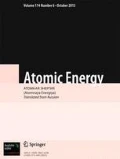Variants of a hypothetical accident that includes the occurrence of a spontaneous chain reaction are examined. The pathways and intensity of radionuclide emission from a nuclear submarine into seawater are determined. The 137Cs accumulation at the time of sinking is determined more accurately. The average and maximum 137Cs emission for use in predicting the contamination of the marine environment in application to the object under study are determined.
Similar content being viewed by others
References
Yu. V. Sivintsev, S. M. Vakulovskii, A. P. Vasil’ev, et al., “Technogenic radionuclides in the seas laving Russia. Radioecological consequences of the disposal of radwastes in the Arctic and Far-Eastern seas,” White Paper 2000, IzdAT, Moscow (2005).
A. A. Sarkisov, V. L. Vysotskii, Yu. V. Sivintsev, et al., “Results of the initial stage of radiation monitoring in the region of sinking of the nuclear submarine K-159,” Izv. Akad. Nauk. Ser. Energetika, No. 6, 102–108 (2004).
A. A. Sarkisov, V. L. Vysotskii, Yu. V. Sivintsev, et al., Atomic Legacy of the Cold War at the Bottom of the Arctic, IBRAE RAN, Moscow (2009).
A. A. Sarkisov, V. L. Vysotskii, Yu. V. Sivintsev, et al., “Problems of radiological rehabilitation of the Arctic seas and solution methods and paths,” Arktika: Ekol. Ekon., No. 1, 72–84 (2010).
S. V. Antipov, V. N. Bilashenko, V. L. Vysotskii, et al., “Prediction and evaluation of the radioecological consequences of a hypothetical accident on the nuclear submarine B-159 sunken in the Barents Sea,” At. Énerg., 119, No. 2, 106–113 (2015).
H. Heldal, F. Vikeb, and G. Johansen, “Dispersal of the radionuclide caesium-137 from point sources in the Barents and Norwegian Seas and its potential contamination of the Arctic marine food chain: coupling numerical ocean models with geographical fi sh distribution data,” J. Envir. Pollut., 180, 190–198 (2013).
S. A. Bogatov, S. L. Gavrilov, V. A. Danilyan, et al., Evaluation of the Yield of Radionuclides for a Number of Hypothetical Accidents at Naval Objects, Preprint IBRAE No. IBRAE-2001.
A. A. Sarkisov, S. V. Antipov, and V. L. Vysotskii, High-Priority Projects of the Program for the Rehabilitation of the Arctic Seas from Radiation Hazardous Objects and the Need for International Collaboration, IAEA, Paris (2012).
K. Hermansen, O. Selnæs, I. Eikelmann, et al., Havariet av den Russiske Atomubåten K-159 og den Norske Atomberedskapsorganisasjonens Håndtering av Ulykken, Strålevern Rapport 2006:8. Statens strålevern, Osterås.
I. V. Lisovskii, “Sunken nuclear submarines – how real is the radiological hazard?” Podvod. Tekhnol., No. 5–6, 8–16 (2006).
I. A. Gaponov, A. Yu. Kazennov, A. V. Korolev, et al., “Radiation monitoring of the nuclear submarine K-159,” Bezop. Okruzh. Sredy, No. 1, 98–101 (2009).
Global Threat Reduction Programme, Department for Business, Enterprise, and Regulatory Reform (BESS), UK, 5th Ann. Report (2007), рp. 74–75
S. V. Antipov, V. L. Vysotskii, and Yu. V. Sivintsev, Engineering-Radiological Inspection of Submerged Objects – Determining Link in the Development of a Comprehensive Program of Radiological Rehabilitation of Arctic Seas, IAEA, Oslo (2011).
V. L. Vysotskii, Yu. V. Sivintsev, V. A. Sotnikov, et al., “Emission of technogenic radionuclides into seawater from sunken and submerged nuclear and radiation hazardous objects,” Izv. Akad. Nauk. Energetika, No. 1, 38–54 (2014).
V. A. Danilyan, V. L. Vysotskii, V. S. Nikitin, et al., Effect of the Salvaging of Nuclear Submarines on the Ecology of the State Center for Building Nuclear Powered Ships in Russia, IBRAE Preprint, No. IBRAE-2001.
Yu. V. Sivintsev, V. L. Vysotskii, and V. A. Danilyan, “Radioecological consequences of a serious radiological accident on the nuclear submarine in Bukhta Chazhma in 1985,” At. Énerg., 76, No. 2, 158–160 (1994).
Y. Nomura and H. Okuno, “Simplifi ed evaluation models for total fi ssion number in a criticality accident,” Nucl. Technol., 104, 142–148 (1995).
Zh. Libman, On Nuclear Safety, Institute of Nuclear and Radiological Safety, Paris (1997).
D. M. Parfanovich, “Summary of the two criticality accidents at the RRC Kurchatov Institute,” in: 6th Int. Conf. on Nuclear Criticality Safety, France (1999), pp. 866–873.
Yu. V. Sivintsev, “Was the accident in Chazhma the far-east Chernobyl?” At. Énerg., 94, No. 6, 472–479 (2002).
Cross-Border Environmental Problems Emanating from Defense-Related Installations and Activities, Phase 1, 1993–1995, Vol. 1, Radioactive Contamination, NATO/CCMS Report No. 204 (1995).
S. V. Ignat’ev and A. N. Zabud’kov, “Nuclear and radiation safety of long-time storage of spent nuclear fuel of reactor installations of ground-based stands of prototypes 27/VT and KM-1,” in: Scientific and Technical Problems of Safe Management of Spent Nuclear Fuel and Radioactive Wastes from Salvaged Nuclear Submarines and Surface Ships with Nuclear Installations, Moscow (2007), Vol. 1, pp. 63–69.
L. Soffer, S. Burson, C. Ferrel, et al., Accident Source Term for Light-Water Nuclear Installation, US Nuclear Regulatory Commission, Washington, Final Rep. (1995).
Primary System Fission Product Release and Тransport: A State-of-the-Art Report to the Committee on the Safety of Nuclear Installations, US Nuclear Regulatory Commission, Washington (1994).
L. Devell, S. Guntay, and D. Powers, The Chernobyl Reactor Accident Source Term, OEСD–NEA, Paris (1995).
A. A. Borovoi and A. Yu. Gagarinskii, “Emission of radionuclides from the destroyed unit of the Chernobyl NPP,” At. Énerg., 90, No. 2, 137–145 (2001).
USSR State Committee on the Utilization of Atomic Energy, “The accident at the Chernobyl NPP and its consequences,” IAEA Post Accident Review Meeting, Vienna, Aug. 25–29, 1986.
Author information
Authors and Affiliations
Additional information
Translated from Atomnaya Énergiya, Vol. 119, No. 4, pp. 222–230, October, 2015.
Rights and permissions
About this article
Cite this article
Sarkisov, A.A., Antipov, S.V., Bilashenko, V.P. et al. Evaluation of Radionuclide Emission into the Environment in the Case of the Accident on the Sunken Nuclear Submarine B-159. At Energy 119, 275–284 (2016). https://doi.org/10.1007/s10512-016-0060-8
Received:
Published:
Issue Date:
DOI: https://doi.org/10.1007/s10512-016-0060-8


